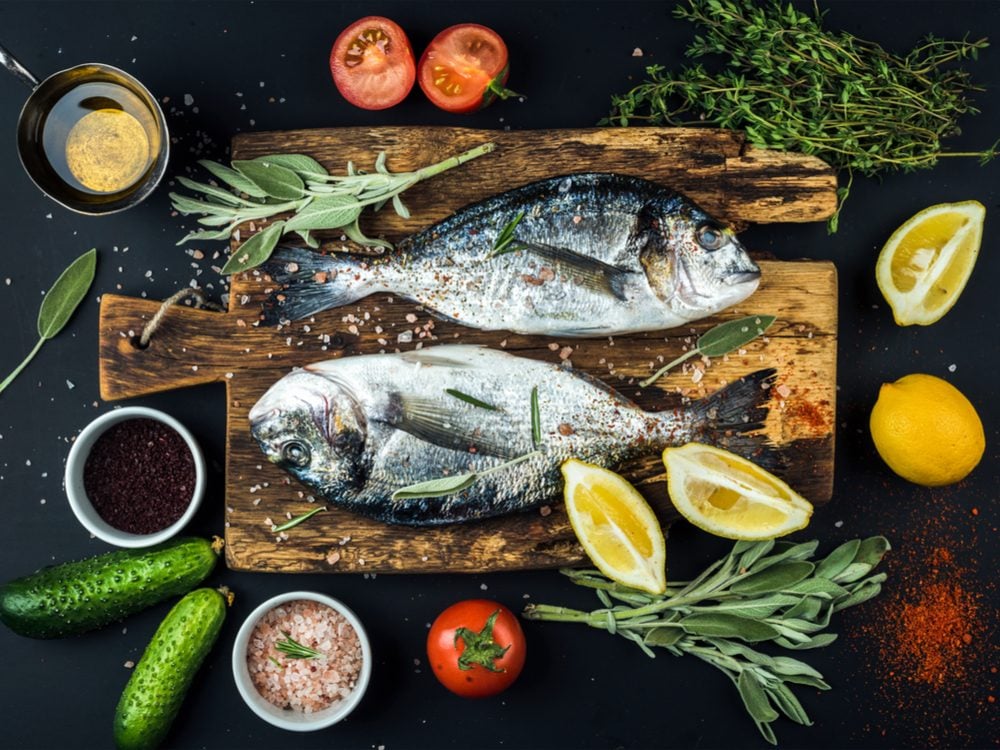Soothe a Sore Throat with These Homemade Gargles
To soothe a sore throat, it’s hard to beat a lemon-juice-in-water gargle. The astringent juice helps shrink swollen throat tissue and creates a hostile environment for viruses and bacteria. Just mix a teaspoon lemon juice in a cup of water.
There’s also plain old salt water. Use 1/4 teaspoon salt in a cup of warm water. Add a tablespoon of Listerine for germ-killing power.
For a more creative concoction try blending one teaspoon of sage, 1/2 teaspoon of alum, 1/4 cup of brown sugar, 3/8 cup vinegar, and 1/8 cup water.
Got a sweet-tooth? This sugary remedy makes short work of a sore throat: Mix 1 teaspoon each of powdered ginger and honey, 1/2 cup of hot water, and the juice of 1/2 squeezed lemon. Pour the water over the ginger, then add the lemon juice and honey. Honey coats the throat and also has mild antibacterial properties.
Gargles to Head Off Heartburn
Stop heartburn with a saltwater gargle. The briny solution helps rinse away and neutralize acids in the throat, relieving the burning sensation and promoting fast healing of irritated mucous membranes. Mix 1/4 teaspoon salt in a cup of warm water.
Battle Bad Breath with This Homemade Gargle
Does the taste of Listerine make you cringe? You can make our own mouthwash. Just add two tablespoons of bruised cloves to two cups of vodka, sherry, or light wine, let sit for a week, then strain and bottle. To use, add one to three teaspoons to water.
If alcohol isn’t your thing you can freshen your breath with a quick swish of clove tea. To make the tea, pour a cup of boiling water over one or two teaspoons of bruised cloves, steep, strain, then let cool.
Gargles to Clobber the Common Cold
Next time you feel the sniffles coming on try gargling with a dash of Tabasco sauce in water. Hot-sauce aficionados swear it’s the quickest way to open up clogged airways.
Not hot for hot sauce? Use echinacea, the herbal virus-killer. Add two teaspoons of tincture to a cup of water and gargle three times daily. In addition to easing throat pain, an echinacea gargle will give your immune system the boost it needs to fight the infection.
Lay Into Laryngitis with this Homemade Gargle
If you’re battling laryngitis, there’s no substitute for simply giving your voice a rest and boosting your intake of fluids. But you may be able to speed the healing process by gargling with myrrh. Highly astringent, myrrh is superb at combating inflammation. It’s an antiseptic too. Just add a few drops of tincture of myrrh in a cup of water, and gargle six times a day.
Looking for more homeopathic remedies? Check out these 10 Healing Herbs & Spices!

At Home in Harvey Station
I am very proud to call Harvey Station, N.B., my home. I was born and raised here—like my father, his father before him and, yes, his father before him. With fewer than 400 residents, our hamlet is situated about 35 kilometres southwest of Fredericton and, primarily due to its rich history and the people who have called Harvey home since the mid-1800s, it is close to many hearts around the world. Originally settled by immigrants coming from the Scottish Borders region in 1837, our first settlers carved fields out of the forest and built homesteads out of the trees they harvested to make Harvey Station their home. That steadfast determination to make a prosperous life here still exists today.
If you ever visit, you’ll find that people here are proud of their history and eager to show you what life in Harvey has to offer. (Drone enthusiast Eric Goggin rises to new heights of creativity as he captures the beauty of New Brunswick from above.)
If you walk up the hill from the post office, you’ll probably run into my mother and father. I love them both dearly and they, more than anyone, have taught me to take pride in where I come from.
My father has lived in Harvey for about 85 of his 89 years and he would gladly tell you what life was like in Harvey during that time period. At the age of 14, he found employment driving a cream truck for the Harvey Creamery; after that, he earned his keep logging with one of the McLean boys, an established family in the industry, and he later owned and ran his own car repair garage. So, yes, my dad has seen and done a lot right here in Harvey, and has plenty of stories to share about the early days. My mother, coming from Tweedside, just outside of Harvey, is equally entertaining with her stories of “back in the day.” One family tale she likes to tell involves a turnip being thrown at my grandmother while the crops were being harvested—the culprits being her and her sister! Mom also recounts how the family just loved to sit around and listen to her Uncle Don play the fiddle. You might know him, too—Don Messer of Don Messer’s Jubilee, a native son of Tweedside and Harvey Station.
Early Harvey was a bustling place with many businesses, farms, hardware stores and even a couple of hotels. Some businesses from those early days are still alive and doing well in Harvey. Briggs and Little Woolen Mills has began producing some of the finest yarns in the world since 1857; the W.W.E. Smith food market and general store has been operating out of the same location since 1852; and Watson’s General Hardware has been doing business in the Harvey area since the late 1800s. The Harvey Creamery started up in 1934 and quickly gained a reputation for producing some of the finest butter and cheese in the land. After the creamery’s closure in 1974, Candlelight Furniture moved in to produce furniture from the same location. And we have had many other successful commercial ventures over the years, including an antimony mine located a short drive away.
An outdoors enthusiast’s dream, you will find many lakes for canoeing, kayaking, fishing, swimming or just lazing around beside the fire pit and enjoying life like it is meant to be. The fall brings many people out of the house and into the woods for hunting season in some of the prime hunting territory of the province. In winter, you can find great trails for snowshoeing, cross-country skiing and snowmobiling, or you can try your hand at ice fishing. If you’re more of an indoor person, you can try the bowling alley for some fun, bingo at the local Lions Club every Monday, or one of the many card parties hosted at one of the local halls.
For me and many other like-minded locals, the most fun takes place at the Harvey Curling Club. The club got its start in 1961 when a few gentlemen from the area got together and built a nice two-sheet rink from the ground up. In the early years, before an ice plant was bought, the coolant was piped over from the nearby Harvey Creamery to keep the artificial ice in top shape. But like so many grassroots curling facilities in Canada, our little club is showing its age and badly needs some renovations. So, in 2014, I started “Curling Across the Nation,” both literally and figuratively. I set out to curl 100 games in 100 different curling clubs across Canada as a way to raise funds for our club to start renovating. I ended the season with 103 games completed. I’m back at it for a second year in a continuing effort to help my hometown curling rink and hopefully to give a boost to curling everywhere I visit.
As you can tell, I love living here and calling Harvey Station my home. The people here make living in Harvey very easy; they care about you and what’s going on in your life, and will lend a hand whenever needed. We’d love to show you what our town is all about, so don’t be shy about paying us a visit. The Harvey Community Days, held on the second weekend of August, is a great time to do precisely that!
Plus: 10 Charming Canadian Towns You Need to Visit

Buckingham Palace, London – June 5, 1961
It is barely four months since President Kennedy’s inauguration. Mrs. Kennedy is still finding her feet.
Jackie is unsure of herself. In public, she smiles and waves. In private, she bites her nails and chain smokes. She is prone to self-pity. She is overheard saying, “Oh, Jack, I’m so sorry for you that I’m such a dud,” to which Kennedy replies, “I love you as you are.” Is each of them telling only half the truth?
Socially, she is an awkward mix of the gracious and the paranoid. “At one moment, she was misunderstood, frustrated, and helpless. The next moment, without any warning, she was the royal, loyal first lady to whom it was almost a duty to bow, to pay medieval obeisance,” is the way her English friend Robin Douglas-Home puts it. “Then again, without any warning, she was deflating someone with devastating barbs for being such a spaniel as to treat her as the first lady and deriding the pomp of politics, the snobbery of the social climber.”
But now, on their whistle-stop tour of Europe, Jackie suddenly appears formidable. The French take to her as one of their own: Born a Bouvier, she has French ancestry, and she spent a year at the Sorbonne. She speaks fluent French and has arrived with a wardrobe of clothes specially designed for her by Givenchy. At a banquet at Versailles, President de Gaulle greets her by saying, “This evening, Madame, you are looking like a Watteau.”
The political editor of TIME reports that “thanks in large part to Jackie Kennedy at her prettiest, Kennedy charmed the old soldier into unprecedented flattering toasts and warm gestures of friendship.” At a press conference, President Kennedy says, “I do not think it altogether inappropriate to introduce myself…I am the man who accompanied Jacqueline Kennedy to Paris, and I have enjoyed it.”
A few days later, after a stop in Vienna to see Soviet Premier Nikita Khrushchev, they attend the christening of Jackie’s niece Tina. From there, they go to an informal lunch with the prime minister and a number of friends and relations, including the Ormsby-Gores and the duke and duchess of Devonshire. The duchess, an old friend of the president, has mixed feelings about Jackie. “She is a queer fish. Her face is one of the oddest I ever saw. It is put together in a very wild way,” the duchess observes to her old friend Patrick Leigh Fermor.
That evening, the Kennedy’s attend a dinner at Buckingham Palace. It proves a minefield. The guest list has been the subject of negotiation: Traditionally, divorcées are not invited, so the queen has been reluctant to welcome Jackie’s sister Princess Lee Radziwill, who is on her second marriage, or her husband, Prince Stanislaw Radziwill, who is on his third. Under pressure, she relents, but, by way of retaliation, singularly fails to invite Princess Margaret or Princess Marina, both of whose names Jackie has put forward. Jackie’s old paranoia returns: She sees it as a plot to do her down. “The queen had her revenge,” she confides to Gore Vidal. “No Margaret, no Marina, no one except every Commonwealth minister of agriculture they could find.” Jackie also tells Vidal that she found the queen “pretty heavy going.” (When Vidal repeats this to Princess Margaret some years later, the princess loyally explains, “But that’s what she’s there for.”)
Over dinner, Jackie continues to feel awkward, even persecuted. “I think the queen resented me. Philip was nice, but nervous. One felt absolutely no relationship between them.”
The queen asks Jackie about her visit to Canada. Jackie tells her how exhausting she found being on public view for hours on end. “The queen looked rather conspiratorial and said, ‘One gets crafty after a while and learns how to save oneself.’” According to Vidal (who is prone to impose his own thoughts on others), Jackie considers this the only time the queen seems remotely human.
After dinner, the queen asks Jackie if she’d like to see “some pictures.” Yes, says Jackie, she certainly would. The queen takes her for a stroll down a long gallery in the palace. They stop in front of a Van Dyck. The queen says, “That’s a good horse.” Yes, agrees Jackie, that is a good horse. From Jackie’s account, this is the extent of their contact with one another, but others differ. Dinner at Buckingham Palace, writes Prime Minister Harold Macmillan in his diary that night, is “very pleasant.”
Nine months later, Jackie pays another visit to the queen at Buckingham Palace, this time by herself. She is more in the swing of things now. “I don’t think I should say anything about it except how grateful I am and how charming she was,” she tells the television cameras as she makes her escape.
Check out 7 Things You Didn’t Know About The Queen.

Why some people tell homophobic and sexist jokes
Jokes are supposed to be funny—they’re meant to tickle us, and make us smirk and giggle. They shouldn’t be overtly offensive or demean a subsection of society, be it women, homosexuals, or any other group. Homophobic or sexist jokes may seem like “no big deal” on the surface, but their underlying message is ultimately very damaging, whether or not that’s their intention. So, why do some people think nothing of telling off-colour jokes?
Well, according to a recent study, “Restoring Threatened Masculinity: The Appeal of Sexist and Anti-Gay Humor,” there’s a genuine reason that some guys resort to this type of humour. It has everything to do with how they perceive themselves.
The research, from Western Carolina University, surveyed 387 straight men to determine their personalities, social views, and the type of humour that they preferred. The results suggest that there is an underlying reason that many men turn to anti-gay or sexist jokes. That is that men tended to use these harmful comments as a defense mechanism when they felt that their masculinity was being threatened in some way.
“Men higher in precarious manhood beliefs expressed amusement with sexist and anti-gay humour in response to a masculinity threat because they believe it reaffirms an accurate, more masculine impression of them,” explains Emma O’Connor, of the Western Carolina University, who led the study. “It appears that by showing amusement with sexist and anti-gay humour, such men can distance themselves from the traits they want to disconfirm.”
In plain English: When some men feel that they are not living up to the norms that are generally associated with masculinity, they may well indulge in these jokes. By mocking a particular group—be it women, gay people, immigrants or the disabled—they are asserting themselves as “different” or “other.” When they laugh at the expense of these groups, what they are really trying to convey is that they share no common ground with them. They are asserting their identity—male and straight.
But wait, why would people use jokes to do this? It’s pretty simple: The major characteristic that sets humour apart from other types of communication is that you can “get away with” more when you say things in the form of a joke. “Given the social protection afforded to humour as a medium for communicating disparagement, it is possible that men use sexist humour in the workplace as a ‘safe’ way to reaffirm their threatened masculinity,” explains O’Connor.
In the workplace, these comments and jokes can often constitute harassment, which is why they need to be prevented. For example, sexist jokes about women can be used to undermine females in a professional setting. O’Connor also noted that managers and bosses have a duty to keep a close eye on what happens within their work. It is also hoped that further research into the use of this detrimental humor will help to prevent it.
And on a lighter note, if you’re a fan of humour, we’re pretty sure you’ll find these clean jokes not at all offensive—and pretty hilarious too.

Which fish have the most Omega-3s?
Omega-3 fatty acids are an important part of a healthy diet because they lower your risk of heart disease, mainly by lowering triglycerides and countering inflammation.
You can find these fats in a variety of non-fish sources, including spinach, mustard greens, wheat germ, walnuts, flaxseed (and flaxseed oil), soybean and canola oil, and even pumpkin seeds. But the very best source is fish.
Not all fish are created equal, however. This handy food chart will help you choose fish with the highest omega-3 content.
These tasty recipes combine your favourite seafood with nature’s best brain-boosting ingredients.

Modern medicine works, but some traditional herbal remedies are increasingly popular—and so effective that doctors recommend them. Beware, however, says London-based GP Dr. Sarah Jarvis: just because they’re natural doesn’t mean they’re safe. “Before taking them, speak to a doctor.” One reason is that they can interact with other medications you might be taking.
Psyllium husk, for constipation
Psyllium adds bulk to your stool to move things along. Dr. Danielle Martin, a Toronto doctor, says, “I often recommend this, as do many gastroenterologists.” (Bonus: Psyllium can lower cholesterol and aid in weight loss, since it makes you feel fuller.)
Black Cohosh, for menopausal hot flushes
“I recommend black cohosh to patients who would prefer not to have hormone-replacement therapy,” Dr. Jarvis says. Studies show it doesn’t work for everyone, but when taken in the dose recommended by your doctor, “it offers a good chance of relief.”
Melatonin, for sleeplessness
Catherine Mounier, 70, of Lyon, France, suffered from insomnia for years. Now, she sleeps well after her doctor, a sleep expert, recommended melatonin supplements. People with insomnia appear to have lower levels of natural melatonin.
Ginger, for nausea
“I recommend this for nausea during pregnancy,” says Dr. Martin. Studies have shown ginger is also effective and safe for nausea and vomiting due to chemotherapy and motion sickness. Indeed, a review (published in 2016 in the journal Integrative Medicine Insights) of studies conducted over the past 30 years concluded ginger works.
St. John’s Wort, for depression
Says Dr. Jarvis: “This is effective for some people with depression if they are unwilling to take a prescription medicine.” A German study of 263 moderately depressed people, published in British Medical Journal in 1999, showed St. John’s wort was effective. As with other antidepressants, Jarvis says, if it doesn’t work, then you and your doctor try other options.
Magnesium, for sleeplessness
Magnesium deficiency can cause insomnia, so supplements could help, especially for insomniacs age 65 plus. Participants in a 2012 trial (published in International Journal of Research Medical Sciences) of 46 people who took a magnesium supplement got more, and better-quality, sleep.
Fish oil, for rheumatoid arthritis
Dr. Jarvis sometimes recommends fish oils for rheumatoid arthritis. Its omega-3 fatty acids helps reduce joint pain and morning stiffness. In a 2008 British study of 97 RA sufferers, those receiving fish oil supplements were able to reduce their painkillers by 39 per cent compared to only 10 per cent in the placebo group.

Alone at last!
Society After months of searching, the Austrian town of Saalfelden has finally filled a vacant post: the job of hermit at an isolated 350-year-old hermitage built into a cliff high above the town.
When it advertised the vacancy, it received applications from all around the world. The winner was Stan Vanuytrecht (pictured), a 58-year-old Belgian retiree and Catholic deacon, who now lives the hermit life he dreamed of—without heating, running water, internet access or a salary.
Saalfelden’s mayor says Vanuytrecht was chosen because he “radiates calm and comes across as well-anchored”. He will be able to share his grounded qualities with hikers, who come to admire the view and sometimes confide in the hermit.
“It’s important just to listen without talking oneself and without judging,” says Vanuytrecht, who in the past has counseled the homeless, drug addicts, prisoners and psychiatric patients.
His predecessor left after just one summer and had faced criticism from arch-conservative Catholics because he didn’t sport a habit or a beard. Vanuytrecht has both.
Locusts for lunch
Food Insects are now officially on the menu in Switzerland, thanks to a new law that allows the sale of food products containing mealworms, locusts and crickets.
An estimated two billion people around the world include insects in their diet, but they rarely feature on European shopping lists. However, this ecologically sound development is gaining acceptance—other countries such as the UK, France, the Netherlands and Belgium are also allowing the sale of edible insects.
Insects contain as much protein as meat and fish and are rich in essential vitamins and minerals. They use less water, land and emit less greenhouse gases than cattle.
Swiss supermarket Coop plans to sell burgers and meatballs containing mealworms in 100 branches. “We’re convinced there’s a real demand for this culinary speciality,” says spokeswoman Angela Wimmer.
Making seawater drinkable
Science Scientists at Manchester University have invented a sieve that can remove salt from seawater. Their method uses graphene oxide, which is attached to a porous material, creating a membrane. The next step is to discover if the technique can be applied on an industrial scale.

A special wedding guest
Heroes When German insurance executive Johann Beissel (pictured, on left) gave a mouth swab during a drive for potential bone marrow donors at his local hospital, little did he suspect the consequences.
On the other side of the world, in Houston, Texas, leukemia patient Larry Wilson was told he needed a bone marrow transplant to survive, but none of his family members were matches. Then it was discovered that Beissal’s bone marrow matched his. The tissue was flown to Texas and Wilson survived. The men are now best friends. “When I met him for the first time, it was like coming home,” says Beissal, who was a special guest at Wilson’s wedding this summer. “You’re the reason I’m here,” Wilson told him at the ceremony. “And we’re brothers. We are officially brothers.”
Sources: Society: The Guardian, 19.4.2017. Food: The Local (Switzerland), 1.5.2017. Science: BBC News, 3.4.2017. Heroes: USA Today, 13.4.2017

Considering changing your car battery? Read this first!
1. With proper care, a car battery can last as long as five years. If you live in a hot climate, however, battery failure can occur in as little as three years.
2. Some of the leading causes of premature car battery failure include chronic overcharging (or undercharging), abuse and excessive vibration.
3. Even when your car is parked, its computer systems are creating a small—but constant—drain on your car battery.
4. Before attempting to change your car battery yourself, consult your owner’s manual. Set aside approximately 30 minutes to complete the job.
5. It’s important you source the right replacement battery. To eliminate guesswork, bring your old battery with you to the auto parts store.
6. Your new car battery should be fully charged prior to installation, otherwise you risk overloading and/or damaging the charging system. (It’s not designed to recharge a dead battery.)
7. The order in which you disconnect the dead car battery’s cables is key: Always disconnect the negative cable first.
8. To lift the dead battery out of the car, you’ll have to remove remove the battery hold-down or clamping device.
9. Car batteries contain electrolyte solution, which is an extremely corrosive acid. Keep the battery in an upright position to prevent this solution from leaking.
10. After placing the new battery in the battery tray, secure it with the hold-down or clamping device. This helps to reduce vibration—one of the key contributing factors in premature car battery failure.
11. Check the battery cables for corrosion, and, if necessary, clean them. Apply grease or petroleum jelly under the clamps to prevent further corrosion.
12. Check out these 10 Tips to Ensure a Long Life for Your New Car Battery!
For more great tips on how to maintain your car and to find the parts you need, visit NAPA Canada.

If you’ve ever taken a handwritten prescription from a doctor or looked at the notes from your visit, it seems like no amount of squinting could help the letters get clearer. Bad handwriting almost seems like a requirement for graduating med school.
It’s not like only people with bad handwriting are attracted to the medical field. Ruth Brocato, MD, primary care doctor with Mercy Medical Center, says she went from winning a penmanship award in grade school to having totally illegible script now. “I know other people have trouble deciphering my notes,” says Dr. Brocato, who adds that she can usually read her own writing. So what gives?
For one thing, doctors have to write more than just about any other job. “In the medical field, if it’s not documented, it didn’t happen,” says Celine Thum, MD, medical director at ParaDocs Worldwide. Anything you talk about behind closed doors needs written evidence for your medical history. (Curious what your handwriting says about you? This handwriting analysis will tell you.)
Long days plus tons of writing equals a very tired hand. “If you’re writing literally for 10 to 12 hours a day and you’re handwriting, your hand just can’t do it,” says Dr. Brocato. Most doctors’ handwriting gets worse over the course of the day as those small hand muscles get overworked, says Asher Goldstein, MD, pain management doctor with Genesis Pain Centers.
If doctors could spend an hour with every patient, they might be able to slow down and give their hands a rest. But the fact is, most physicians are rushing around to the next patient. For instance, one patient might have just 15 minutes to discuss eight medical issues and ask important questions about prescriptions, says Dr. Brocato. With so many patients to see in a limited time, doctors are more concerned with getting the information down than perfecting their handwriting.
The jargon that doctors deal with also lends itself to bad handwriting. Case in point: imagine trying to write “epididymitis” without your computer’s handy spellcheck. “We have so many technical terms that are impossible to write,” says Dr. Thum. “You sometimes scribble to cover the error.”
Plus, some terms that are totally clear to medical experts might leave you scratching your head. For instance, QD is shorthand for a Latin phrase meaning “one a day” and TID means “three times a day.” Your pharmacist would know exactly what your doctor meant, but you’d probably just write it off as chicken scratch.
Dr. Brocato, who now mostly types, says doctors are extra careful when it comes to prescriptions, when a tiny misread could have major consequences. For instance, instead of writing “mg” or “mcg,” doctors were encouraged to write out “milligram” or “microgram.” “If [a dosage] is 100 times what you’re writing, you have to be super careful about that,” she says.
Those tiny nuances in sloppy handwriting could be bad news for treatment. An American report from 2006 found that more than 7,000 people died a year from medical errors caused by illegible handwriting.
Now, doctors are moving toward electronic medical records to cut down on lost-in-translation errors. Some American states even legally require doctors to send in prescriptions electronically instead of passing over handwritten slips. No studies have looked into whether the yearly death rate from wrong prescriptions has gone down, but doctors agree there’s less chance for error. “Things are much more legible than they have been in the past,” says Dr. Goldstein.
Of course, typing everything isn’t perfect either. There’s still the possibility of entering, say, 30 instead of 300, and the process is slower than just scrawling out a prescription. While we’re all for electronic medical records, we’ll write by hand whenever we can.
Plus: The 51 Funniest Things That Ever Happened at the Doctor’s Office

Internet users, beware: Google is always watching
The tech powerhouse recently launched two new hubs, giving us scary insight into what it actually knows about us. “My Account” provides a glimpse into the information the company collects about us and allows us to change our settings, reports Insider. And then there’s a new tool called “My Activity,” where we can view almost all of our online activity that’s tied our Google accounts.
It’s no surprise that the popular search engine collects lots of data about us through our search history, location, and voice searches. Plus, because iPhone and Android devices are tied to our Google accounts, any web or app activity—including our search history and activity in maps—are automatically turned on for tracking. Keeping tabs on our preferences improves Google’s services and provides relevant ads for us. However, here’s the scary part for all you privacy buffs out there: the “My Activity” launch reveals that Google can take a comprehensive look at all of the data it has on you, at any given point in time.
Creepy, right? Thankfully, there’s an easy way to stop Google from tracking your web activity. Go to “My Account” and select “Manage your Google Activity” under the “Personal info & privacy” tab. Selecting “activity controls” will show you what data Google tracks on you. To disable it, simply click the blue slider icon on the right.
Now, let’s say you want to be extra cautious and delete your web activity completely. On your “My Activity” page, select the menu icon (three vertical dots) in the upper right hand corner. Select “Delete activity by” and then, in the drop down menu, choose “All time.” If you want to delete data within a specific time period, just select the certain dates in the drop down menu.
You’ll never guess what Amazon was almost called—and why they had to change the name!